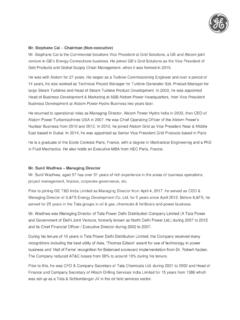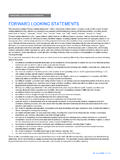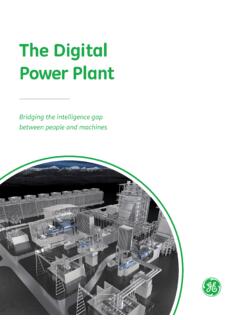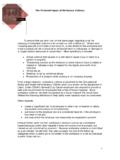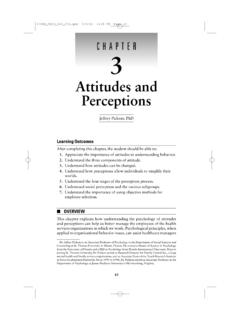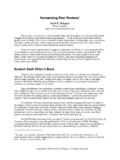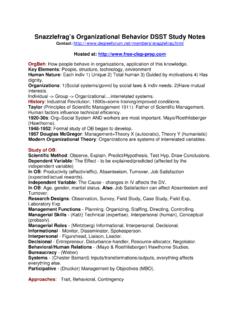Transcription of The Roadmap to Customer Impact - Imagination at …
1 GWe bring good things to lifeWhat Is Six Sigma?The Roadmapto CustomerImpactMaking Customers Feel Six Sigma QualityGlobalization and instant access to information, products and services have changed the wayour customers conduct business old business models no longer work. Today s competitiveenvironment leaves no room for error. We must delight our customers and relentlessly look fornew ways to exceed their expectations. This is why Six Sigma Quality has become a part of our is Six Sigma?First, what it is not. It is not a secret society, a slogan or a clich . Six Sigma is a highlydisciplined process that helps us focus on developing and delivering near-perfect productsand services. Why Sigma ? The word is a statistical term that measures how far a givenprocess deviates from perfection.
2 The central idea behind Six Sigma is that if you canmeasure how many defects you have in a process, you can systematically figure out howto eliminate them and get as close to zero defects as possible. Six Sigma has changedthe DNA of GE it is now the way we work in everything we do and in every prod-uct we s Evolution Towards Quality GE began moving towards a focus on quality in the late 80s. Work-Out , the start of ourjourney, opened our culture to ideas from everyone, everywhere, decimated the bureaucracyand made boundaryless behavior a reflexive, natural part of our culture, thereby creatingthe learning environment that led to Six Sigma. Now, Six Sigma, in turn, is embeddingquality thinking process thinking across every level and in every operation of ourCompany around the in the 1980s defined how we behave.
3 Today, Six Sigma is defining how wework and has set the stage for making our customers feel Six Sigma Quality:The Road to Customer ImpactKey Strategy Initiatives:QMI, NPI, OTR, SM, Productivity, GlobalizationChange Acceleration Process:Increase Success and Acceleration ChangeProcess Improvement:Continuous Improvement, ReengineeringProductivity/Best Practices:Looking Outside GEWork-Out/Town Meetings:Empowerment, Bureaucracy BustingGE s Evolution Towards Quality Key Elements of , Process and EmployeeThere are three key elements of quality: Customer , process and employee. Everything we do to remain a world-classquality company focuses on these three essential CustomerDelighting CustomersCustomers are the center of GE s universe: they define quality.
4 They expect performance, reliability, competitive prices, on-time delivery, service, clear and correct transaction processing and more. In every attribute that influences Customer perception, we know that just being good is not enough. Delighting our customers is a necessity. Because if we don t do it, someone else will!..the Process Outside-In ThinkingQuality requires us to look at our business from the Customer s perspective, not ours. In otherwords, we must look at our processes from the outside-in. By understanding the transactionlifecycle from the Customer s needsand processes, we can discoverwhat they are seeing and this knowledge, we can identify areas where we can addsignificant value or improvementfrom their EmployeeLeadership CommitmentPeople create results.
5 Involving all employees is essential to GE s quality approach. GE is committed to providing opportunities and incentives for employees to focus their talents andenergies on satisfying GE employees are trained in the strategy, statistical tools and techniques of Six Sigmaquality. Training courses are offered at various levels: Quality Overview Seminars: basic Six Sigma awareness. Team Training: basic tool introduction to equip employees to participate on Six Sigma teams. Master Black Belt, Black Belt and Green Belt Training: in-depth quality training that includes high-level statistical tools, basic quality control tools, Change AccelerationProcess and Flow technology tools. Design for Six Sigma (DFSS) Training: prepares teams for the use of statistical tools to design it right the first is the responsibility of every employee.
6 Every employee must be involved, motivatedand knowledgeable if we are to ProcessGE ProcessABCC ustomer sView of GE sContributionGE s Viewof ItsContributionThe Six Sigma StrategyTo achieve Six Sigma quality, a process must produce no more than defects per million opportunities. An opportunity is defined as a chance for nonconformance, or not meeting the required specifications. This means we need to be nearlyflawless in executing our key processes. Six Sigma is a vision we strive toward and a philosophy that is part of our business culture. Key Concepts of Six SigmaAt its core, Six Sigma revolves around a few key concepts. Critical to Quality:Attributes most important to the customerDefect:Failing to deliver what the Customer wantsProcess Capability:What your process can deliver Variation:What the Customer sees and feelsStable Operations:Ensuring consistent, predictable processes to improve what the Customer sees and feelsDesign for Six Sigma:Designing to meet Customer needs and process capabilityOur Customers Feel the Variance, Not the MeanOften, our inside-out view of the business is based on average or mean-based measures of our recent past.
7 Customersdon t judge us on averages, they feel the variance in each transaction, each product we ship. Six Sigma focuses first onreducing process variation and then on improving the process capability. Customers value consistent, predictable business processes that deliver world-class levels of quality. This is what SixSigma strives to s Commitment to QualityGE s success with Six Sigma has exceeded our most optimistic predictions. Across the Company, GE associatesembrace Six Sigma s Customer -focused, data-driven philosophy and apply it to everything we do. We are building on these successes by sharing best practices across all of our businesses, putting the full power of GE behind our quest for better, faster Customer of Terms and DefinitionsQuality Approaches and ModelsDFSS (Design for Six Sigma) is a systematic metho-dology utilizing tools, training and measurements toenable us to design products and processes that meetcustomer expectations and can be produced at Six Sigmaquality (Define, Measure, Analyze, Improve andControl) is a process for continued improvement.
8 It is systematic, scientific and fact based. This closed-loopprocess eliminates unproductive steps, often focuses on new measurements, and applies technology forimprovement. Six Sigma A vision of quality which equates with defects per million opportunities for each product orservice transaction. Strives for ToolsAssociates are exposed to various tools and termsrelated to quality. Below are just a few of Chart Monitors variance in a process overtime and alerts the business to unexpected variancewhich may cause Measurement Accounting for the number or frequency of defects that cause lapses in product or service Diagram Focuses on efforts or the problemsthat have the greatest potential for improvement byshowing relative frequency and/or size in a descendingbar graph.
9 Based on the proven Pareto principle: 20% ofthe sources cause 80% of any Mapping Illustrated description of howthings get done, which enables participants to visualizean entire process and identify areas of strength andweaknesses. It helps reduce cycle time and defects whilerecognizing the value of individual Cause Analysis Study of original reason for nonconformance with a process. When the root cause is removed or corrected, the nonconformance will Process Control The application of statis-tical methods to analyze data, study and monitor processcapability and performance. Tree Diagram Graphically shows any broad goal bro-ken into different levels of detailed actions. It encouragesteam members to expand their thinking when Terms Black Belt Leaders of team responsible for measur-ing, analyzing, improving and controlling key processesthat influence Customer satisfaction and/or productivitygrowth.
10 Black Belts are full-time positions. Control The state of stability, normal variation and pre-dictability. Process of regulating and guiding operationsand processes using quantitative : Critical to Quality (Critical Y ) Element of a process or practice which has a direct Impact on its perceived Needs, Expectations Needs, as defined by customers, which meet their basic requirements Sources of Customer irritation. Defects arecostly to both customers and to manufacturers or serviceproviders. Eliminating defects provides cost Belt Similar to Black Belt but not a Black Belt First and foremost teachers. Theyalso review and mentor Black Belts. Selection criteria forMaster Black Belts are quantitative skills and the abilityto teach and mentor.
